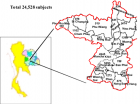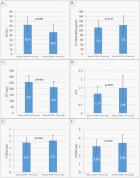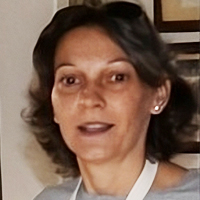Abstract
Research Article
Associated indicator factors among inappropriate malfunctions’ development for the 9-month-old-baby
Narida Rattana-Umpa, Jirawon Tanwatthanakul* and Toansakul Tony Santiboon
Published: 10 September, 2021 | Volume 4 - Issue 1 | Pages: 075-083
To investigate the associated an inappropriate development of the 9-month-old-baby with the Matched Case-Control Study on five categories and three factors including predisposing, contributing, and complementary through the babies’ malfunction development with the Analysis Research Method was analyzed. The babies’ developing crisis was enhanced as the guidelines for promoting healthy babies’ development via the DSPM in the future of Thailand. Creative the Interview Factor Questionnaire analyzed the 130-child caregivers’ parenting matching 65-pairs-case-control group into 5 parts: the Predisposing Factor Questionnaire, the Positive Interview Form; the Baby-Self-Efficacy Form; the Inappropriate Contributing Interview Form; the Inappropriate Development Interview Form for assessing the motor skills, self-efficacy, predisposing, contributing, and complementary factors of the 9-month-old-baby, respectively. Highest, Middle, and Lowest means levels are indicated. The child caregivers’ are presenting responses, overall on the Predisposing Factor Questionnaire on five categories’ motor skills, and the Inappropriate Development Interview Form showed off at the Middle Levels. The Positive Interview Form, the Baby-Self-Efficacy Form, and the Inappropriate Contributing Interview Form comprised at the Highest Levels for the predisposing, self-efficacy, and contributing factors for developing the 9-month-old-baby, respectively. To help professionals assess the factors affecting a child’s development into environmental factors, biological factors, interpersonal relationships, and early environments and experiences that identified in contributing to growth, brain, emotional, social developments at early childhood are the GM, FM, RL, EL, and PS motor skills practices with the DSPM for Thai’s children are also more likely to have health problems all child ages with the knowledge and skills.
Read Full Article HTML DOI: 10.29328/journal.japch.1001038 Cite this Article Read Full Article PDF
Keywords:
Crisis indicators; Associated factors; Inappropriate malfunctions’ development; The 9-month-old-baby; The 21st century; Future children of Thailand
References
- UNICEF for Every Child. Your baby's developmental milestones at 9 months. 2019; https://www.unicef.org/parenting/child-development/your-babys-developmental-milestones-9-months
- Grow by WebMD. Baby development: Your 9-month-old. https://www.webmd.com/parenting/baby/baby-development-9-month-old#1
- The Bump. 9-month-old development. 2019. https://www.thebump.com/baby-month-by-month/9-month-old-baby
- UCSF: Benioff Children’s Hospital. Your Baby at 9 Months. Patient Education. 2019. https://www.ucsfbenioffchildrens.org/education/your-baby-at-9-months
- Gudritz L. 9-month-old baby: Developmental milestones and guidelines. Health Line Parenthood. https://www.healthline.com/health/parenting/9-month-old-baby-milestones
- Fernald A. Talking to babies boosts their brain power; studies show. Support the Guardian: Developmental of Psychologist, Stanford University. https://www.theguardian.com/science/2014/feb/14/talking-to-babies-brain-power-language
- Brusie C. Your 9-month-old baby’s development: Major milestones and everyday tips for your baby at 9 months old. Very Well Family. https://www.verywellfamily.com/your-9-month-old-baby-development-and-milestones-4172786
- Walter, R. S. (2016). Your child's development: 9 months. Kids Health. https://kidshealth.org/en/Parents/development-9mos.html
- ictor R, Baines SK, Agho K, Dibley MJ. Factors associated with inappropriate complementary feeding practices among children aged 6-23 months in Tanzania. Maternal and Child Nutrition. 2012; 10.
- Bureau of Nutrition, Department of Health, Ministry of Public Health. The guideline to drive the miracle of the first 1,000 days of life. Krangthep: A.V. Progressive Co., Ltd. 2018.
- National Strategy Committee. Government gazette on national strategy (2018-2037). https://data.opendevelopmentmekong.net
- Office of the National Economic and Social Development Board. National Economic and Social Development Plan Twelfth Edition 2017 - 2021. https://data.opendevelopmentmekong.net
- Office of the Prime Minister, Ministry of Public Health. Summary the twelfth national economic and social development plan (2017-2021). https://www.nesdc.go.th/ewt_dl_link.php?nid=9640
- Health Promotion Bureau, Department of Health, Ministry of Public Health. Annual reported of the early childhood development survey, fiscal year 2010. www.anamai.moph.go.th.
- The Department of Health, the Ministry of Public Health. Public health statistics 2014 A.U. http://planning.anamai.moph.go.th/download/D_DataMarts/Stat/health_statistics2557.pdf
- National Institute of Child Health Development, Department of Health, Ministry of Public Health. A manual for monitoring and promoting early childhood development. Bangkok: Printing Affairs Office, The War Veterans Organization Press. 2018.
- Khon Kaen Provincial Health Office 7. Summary of the results of the civil service inspection and supervision of the second fiscal year 2016. www.healtharea.net
- National Institute of Child Health Development, Department of Health. Situation of Thai child development, 2017 random survey. http://nich.anamai.moph.go.th
- Ministry of Public Health. Particular of indicators of the Ministry of Public Health for the fiscal year 2018. Nonthaburi: Ministry of Public Health. 2017. http://dmsic.moph.go.th/index/detail/6785
- Kueaed N, Chaimail P, Woradej S. Situations and factors relating to development of Thai children under 5 years: A literature review. J Southern College Nurs Public Health Networks. 2018; 5: 281-296.
- Bunjiam S, Siwarom W, Ratanun Y, Pornnasaphat S. Situation of early childhood development in Thailand, Health Area No. 7. J Health Center. 2016; 8: 15-29.
- Lind JN, Li R, Perrine CG, Schieve LA. Breastfeeding and later psychosocial development of children at 6 years of age. 2014; 134: S36–S41. PubMed: https://pubmed.ncbi.nlm.nih.gov/25183753/
- Santos IS, Barros AJD, Barros FC, Munhoz TN, Da-Silva BDP, et al. Mother-child bed-sharing trajectories and psychiatric disorders at the age of 6 years. Affect. Disord. 2017; 2017: 163–169. PubMed: https://pubmed.ncbi.nlm.nih.gov/27788379/
- Ratanan Y. Study of factors affecting early childhood development in Thailand, Health Area 8. 2014. http://kcenter.anamai.moph.go.th
- Green LW, Kreuter MW. Health program planning: an educational and ecological approach, 4th edition. New York. McGraw-Hill. 2005.
- Information Center for Administration and Administration. Khon Kaen Province: Administrative Information. Department of Provincial Administration. Ministry of Interior. 2020. http://www.dopa.go.th/padmic/jungwad76/jungwad76.htm
- Khon Kaen Provincial Public Health Office 7. Service network. 2019. http://www.kkpho.go.th
- The Ministry of Public Health. Percentage of children aged 0-5 years with healthy development. 2019. moph.go.th
- Suwanrungruang K. Khon Kaen Province: Map showing of subjects recruited by district: A prospective study of diet, lifestyle, and genetic factors and the risk of cancer in Khon Kaen Province, Northeast Thailand. 2005. https://www.researchgate.net/figure/Khon-Kaen-Province-Map-Showing-of-Subjects-Recruited-by-District-Amphur
- Bloom BS. Learning for Mastery (PDF). UCLA - CSEIP - Evaluation Comment. 1.
- Best JW. Research in education. (3 rd ed). New Jersey: Prentice hall Inc. 1977.
- Best JW, Kahn JV. Research in education. 8th Edition, Butler University, Emeritus, University of Illinois, Chicago. 1998.
- Thainuae W. DSPM-developmental surveillance and promotion manual. National Health Security Office. The Office of Printing Affairs, the War Veterans Organization of Thailand. The ministry of Public Health 2018.
- Health System Research Institute. Thai child development problems with a developmental approach that aligns with 21st century children's skills. 2020. https://www.hsri.or.th/media/news/detail/12472
- World Health Organization. Nurturing care for early childhood development: A framework for helping children survive and thrive to transform health and human potential. 2018. https://apps.who.int/iris/bitstream/handle/10665/272603/9789241514064-eng.pdf?sequence=1&isAllowed=y
- Chuenklin, N., Director of Health System Research Institute. 30% of Thai children are impatient, revealing 4 plans for 21st century child development. Bangkok Biz News. 2018. https://www.bangkokbiznews.com/news/detail/822506
- Duncan J, Arntson L. Children in crisis: Good practices in evaluating psychosocial programming. The International Psychosocial Evaluation Committee and Save the Children Federation, Inc. Supported by Andrew W. Mellon Foundation. 2004.
- Bumrungkit S. Poverty, vulnerability and food insecurity in Thailand. Ph.D. Thesis at the School of Economics and Finance. Curtin Business School, Curtin University of Technology, Australia. 2014.
- Aparna M. Your 9 months old baby growth and development. First Cry Parenting. 2018. https://parenting.firstcry.com/articles/your-9-months-old-baby-growth-and-development/
- Center for Disease Control and Prevention. Facts about developmental disabilities. CDC: Solving Lives, Protecting People. 2020. https://www.cdc.gov/ncbddd/developmentaldisabilities/facts.html
- Royal Socialty Thwink. Analysis method: Sustainability Problem. 2009. https://www.thwink.org/sustain/glossary/AnalyticalMethod.htm
Figures:

Figure 1
Similar Articles
-
Associated indicator factors among inappropriate malfunctions’ development for the 9-month-old-babyNarida Rattana-Umpa,Jirawon Tanwatthanakul*,Toansakul Tony Santiboon. Associated indicator factors among inappropriate malfunctions’ development for the 9-month-old-baby. . 2021 doi: 10.29328/journal.japch.1001038; 4: 075-083
-
Factors Associated with Elevated Transcranial Doppler Ultrasound Velocities in Children With Sickle Cell Anemia in Mwanza, TanzaniaGeorgina George Balyorugulu, Emmanuela Ambrose, Patrick S Ngoya, Yusuf S Jamnagerwalla, Iddi S Buri, Primrose Songoro, Protas D Komba. Factors Associated with Elevated Transcranial Doppler Ultrasound Velocities in Children With Sickle Cell Anemia in Mwanza, Tanzania. . 2023 doi: 10.29328/journal.japch.1001058; 6: 033-038
-
Prevalence and Associated Factors of Hypoglycemia among Severe Acute Malnourished Children who admitted in East Gojjam Zone Public Hospitals from 2018 to 2021, Northwest Ethiopia, 2022. Multi-center Retrospective Cross Sectional StudyYitayal Guadie Ashebir*, Yohannes Godie, Aster Tadesse, Esmelalem Mihretu, Dires Birhanu. Prevalence and Associated Factors of Hypoglycemia among Severe Acute Malnourished Children who admitted in East Gojjam Zone Public Hospitals from 2018 to 2021, Northwest Ethiopia, 2022. Multi-center Retrospective Cross Sectional Study. . 2024 doi: 10.29328/journal.japch.1001066; 7: 037-044
Recently Viewed
-
Agriculture High-Quality Development and NutritionZhongsheng Guo*. Agriculture High-Quality Development and Nutrition. Arch Food Nutr Sci. 2024: doi: 10.29328/journal.afns.1001060; 8: 038-040
-
A Low-cost High-throughput Targeted Sequencing for the Accurate Detection of Respiratory Tract PathogenChangyan Ju, Chengbosen Zhou, Zhezhi Deng, Jingwei Gao, Weizhao Jiang, Hanbing Zeng, Haiwei Huang, Yongxiang Duan, David X Deng*. A Low-cost High-throughput Targeted Sequencing for the Accurate Detection of Respiratory Tract Pathogen. Int J Clin Virol. 2024: doi: 10.29328/journal.ijcv.1001056; 8: 001-007
-
A Comparative Study of Metoprolol and Amlodipine on Mortality, Disability and Complication in Acute StrokeJayantee Kalita*,Dhiraj Kumar,Nagendra B Gutti,Sandeep K Gupta,Anadi Mishra,Vivek Singh. A Comparative Study of Metoprolol and Amlodipine on Mortality, Disability and Complication in Acute Stroke. J Neurosci Neurol Disord. 2025: doi: 10.29328/journal.jnnd.1001108; 9: 039-045
-
Development of qualitative GC MS method for simultaneous identification of PM-CCM a modified illicit drugs preparation and its modern-day application in drug-facilitated crimesBhagat Singh*,Satish R Nailkar,Chetansen A Bhadkambekar,Suneel Prajapati,Sukhminder Kaur. Development of qualitative GC MS method for simultaneous identification of PM-CCM a modified illicit drugs preparation and its modern-day application in drug-facilitated crimes. J Forensic Sci Res. 2023: doi: 10.29328/journal.jfsr.1001043; 7: 004-010
-
A Gateway to Metal Resistance: Bacterial Response to Heavy Metal Toxicity in the Biological EnvironmentLoai Aljerf*,Nuha AlMasri. A Gateway to Metal Resistance: Bacterial Response to Heavy Metal Toxicity in the Biological Environment. Ann Adv Chem. 2018: doi: 10.29328/journal.aac.1001012; 2: 032-044
Most Viewed
-
Evaluation of Biostimulants Based on Recovered Protein Hydrolysates from Animal By-products as Plant Growth EnhancersH Pérez-Aguilar*, M Lacruz-Asaro, F Arán-Ais. Evaluation of Biostimulants Based on Recovered Protein Hydrolysates from Animal By-products as Plant Growth Enhancers. J Plant Sci Phytopathol. 2023 doi: 10.29328/journal.jpsp.1001104; 7: 042-047
-
Sinonasal Myxoma Extending into the Orbit in a 4-Year Old: A Case PresentationJulian A Purrinos*, Ramzi Younis. Sinonasal Myxoma Extending into the Orbit in a 4-Year Old: A Case Presentation. Arch Case Rep. 2024 doi: 10.29328/journal.acr.1001099; 8: 075-077
-
Feasibility study of magnetic sensing for detecting single-neuron action potentialsDenis Tonini,Kai Wu,Renata Saha,Jian-Ping Wang*. Feasibility study of magnetic sensing for detecting single-neuron action potentials. Ann Biomed Sci Eng. 2022 doi: 10.29328/journal.abse.1001018; 6: 019-029
-
Pediatric Dysgerminoma: Unveiling a Rare Ovarian TumorFaten Limaiem*, Khalil Saffar, Ahmed Halouani. Pediatric Dysgerminoma: Unveiling a Rare Ovarian Tumor. Arch Case Rep. 2024 doi: 10.29328/journal.acr.1001087; 8: 010-013
-
Physical activity can change the physiological and psychological circumstances during COVID-19 pandemic: A narrative reviewKhashayar Maroufi*. Physical activity can change the physiological and psychological circumstances during COVID-19 pandemic: A narrative review. J Sports Med Ther. 2021 doi: 10.29328/journal.jsmt.1001051; 6: 001-007

HSPI: We're glad you're here. Please click "create a new Query" if you are a new visitor to our website and need further information from us.
If you are already a member of our network and need to keep track of any developments regarding a question you have already submitted, click "take me to my Query."















































































































































